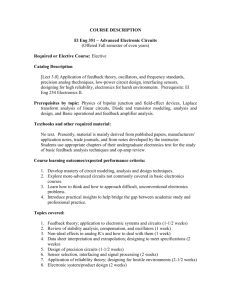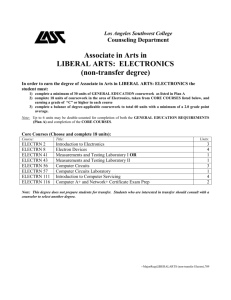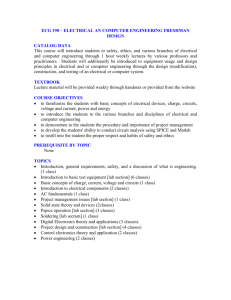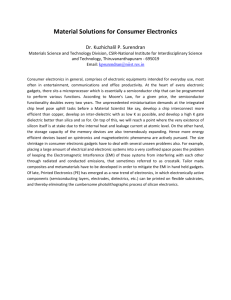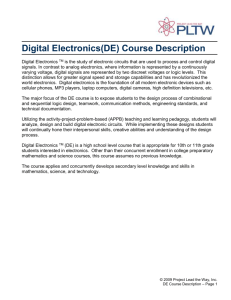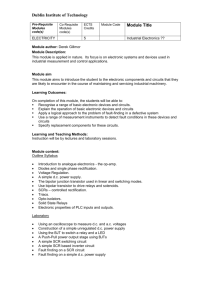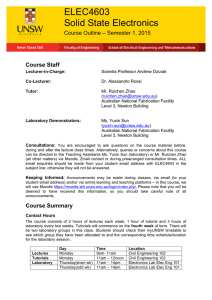ELEC4603 (Solid State Electronics) - Engineering
advertisement
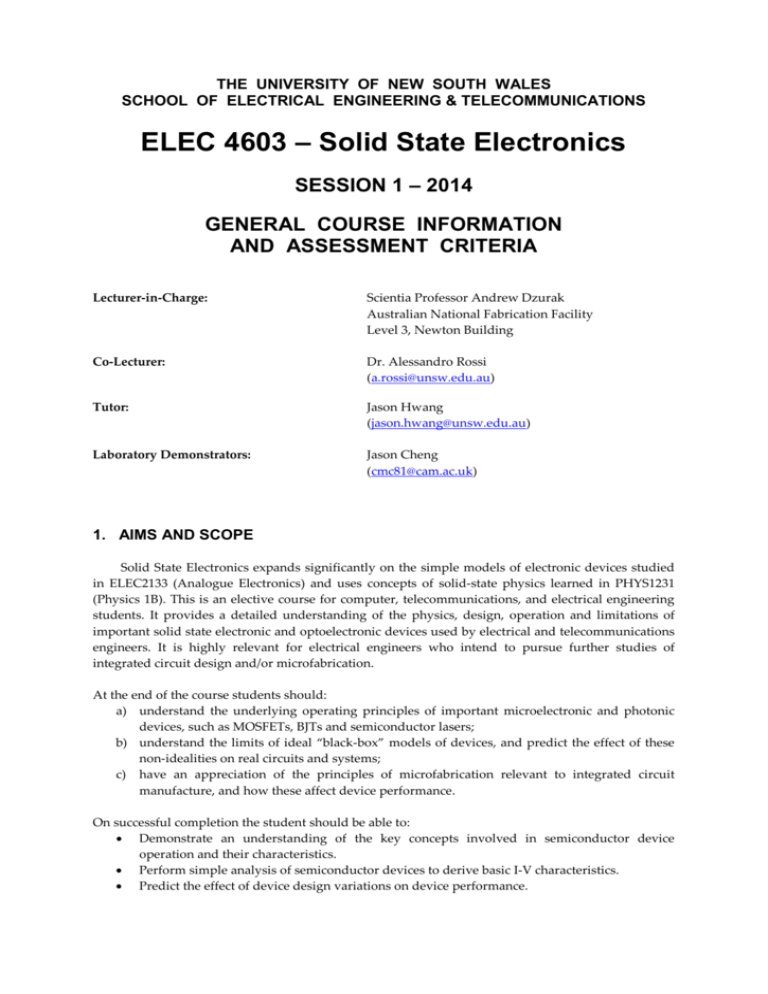
THE UNIVERSITY OF NEW SOUTH WALES SCHOOL OF ELECTRICAL ENGINEERING & TELECOMMUNICATIONS ELEC 4603 – Solid State Electronics SESSION 1 – 2014 GENERAL COURSE INFORMATION AND ASSESSMENT CRITERIA Lecturer-in-Charge: Scientia Professor Andrew Dzurak Australian National Fabrication Facility Level 3, Newton Building Co-Lecturer: Dr. Alessandro Rossi (a.rossi@unsw.edu.au) Tutor: Jason Hwang (jason.hwang@unsw.edu.au) Laboratory Demonstrators: Jason Cheng (cmc81@cam.ac.uk) 1. AIMS AND SCOPE Solid State Electronics expands significantly on the simple models of electronic devices studied in ELEC2133 (Analogue Electronics) and uses concepts of solid-state physics learned in PHYS1231 (Physics 1B). This is an elective course for computer, telecommunications, and electrical engineering students. It provides a detailed understanding of the physics, design, operation and limitations of important solid state electronic and optoelectronic devices used by electrical and telecommunications engineers. It is highly relevant for electrical engineers who intend to pursue further studies of integrated circuit design and/or microfabrication. At the end of the course students should: a) understand the underlying operating principles of important microelectronic and photonic devices, such as MOSFETs, BJTs and semiconductor lasers; b) understand the limits of ideal “black-box” models of devices, and predict the effect of these non-idealities on real circuits and systems; c) have an appreciation of the principles of microfabrication relevant to integrated circuit manufacture, and how these affect device performance. On successful completion the student should be able to: • Demonstrate an understanding of the key concepts involved in semiconductor device operation and their characteristics. • Perform simple analysis of semiconductor devices to derive basic I-V characteristics. • Predict the effect of device design variations on device performance. Assess the relative advantages/disadvantages of different classes of electronic and optoelectronic devices for particular applications. • Design simple optoelectronic communication systems. • Demonstrate an understanding of the technologies used in integrated circuit manufacture and the impact of these technologies on device design and performance. This subject endeavours to teach students not only just how these electronic devices operate, but also develop some insight into the underlying solid-state physics. The topics to be covered include the following: • Band-structure and doping of semiconductors. Drift-Diffusion Equations; Density of states; Fermi function; Law of Mass Action. PN Junctions: Derivation of I-V characteristics. PN Junctions: Capacitance; Breakdown; Non-idealities. Bipolar Junction Transistor (BJT): Operation principles. BJT: Derivation of I-V characteristics. BJT: Ebers-Moll model; Non-idealities. MOSFET: Derivation of I-V characteristics. MOSFET: Structure; Threshold Voltage; Enhancement- & Depletion-mode. Microwave devices. Transistors for Digital Logic: TTL, ECL, CMOS. Optoelectronic & Photonic Devices: Direct Vs Indirect Band-gap devices. LEDs; Semiconductor Lasers; Photovoltaic Cells. Principles and key technologies involved in microfabrication of integrated circuits. Microfabrication of: MOSFETs; CMOS; BJTs. 2. TEACHING METHODS Lectures: 2 hrs/week Tutorials: 1 hr/fortnight Labs: 3 hrs/fortnight 3. PREREQUISITES The prerequisite for Solid State Electronics is ELEC2133 (Analogue Electronics). It will be assumed that students have mastered this subject. Students are strongly advised to revise any unfamiliar topics in their own time. 4. TEXTBOOK AND REFERENCES The textbook set for this course is: Muller & Kamins, Device Electronics for Integrated Circuits, 3rd ed., Wiley, 2003 - P621.3815/308 (UNSW Library) An alternative texbook, which covers much of the same material, but with greater emphasis on semiconductor fabrication, is: S. M. Sze, Semiconductor Devices: Physics and Technology, 2nd ed., Wiley, 2002 - P621.38152/120 (UNSW Library) In addition to the textbooks which combine the semiconductor devices and electronics, other reference books include semiconductor device textbooks and electronic circuit textbooks. For semiconductor devices, a series of books which covers operation of devices in a clear, readable manner with many good analogies and explanations is The Modular Series on Solid State Devices edited by R.F. Pierret and G.W. Nuedeck. Each volume is short, covering a specific topic only. The volumes of interest are I, II, III and IV. Although the material is covered at a basic level, the treatment is very complete and, consequently, for this course, not all sections are relevant. The material covered by textbooks dealing exclusively with electronics circuits has remained relatively unchanged over many years and consequently there are many well-polished textbooks. Three of the more popular ones are listed below. Of the three, Millman & Grabel has a more theoretical and complete approach, particularly for feedback and frequency response. Sedra & Smith has the best coverage of device fabrication. Burns & Bond approaches electronic circuits from a semiconductor physics perspective and was formerly the textbook for this course. All three textbooks have some coverage of digital circuits. Sedra & Smith, Microelectronic Circuits, 4th ed., Oxford University Press, 1998. Millman & Grabel, Microelectronics, McGrawHill, 2nd ed., NY. Burns & Bond, Principles of Electronic Circuits, PWS, 2nd ed.,1997. Finally, for those interested in designing and building realistic functioning circuits, a variety of books exists which give examples of many types of circuits. Several such books exists, but a well-respected and popular anthology of circuits with many useful practical tips is The Art of Electronics. Horowitz & Hill, The Art of Electronics, 2nd ed., Cambridge University Press, 1989. 5. ASSESSMENTS Assessments in this subject will be based on the following scheme: Laboratory (2 experiments) Assignment (1) Final Examination 20% 10% 70% You must pass both the laboratory component and the exam component to attain an overall pass in the course. The final examination is a three hour closed book written examination covering all aspects of the course that have been presented in lectures, tutorials, and labs. All parts of the assessment will be marked according to the amount of work done, the correctness of the work, and the displayed knowledge and understanding of the topic. 6. THE COURSE WEBSITE The course Moodle site will be the primary point of contact, for administrative matters, with the student. Any important announcements will be placed on the Announcements page, which the student is obliged to check regularly. Lecture notes, tutorial questions and laboratory notes will also be progressively made available for download on this site. All enrolled students should have access to the ELEC4603 Solid State Electronics Moodle site, which may be accessed at: http://moodle.telt.unsw.edu.au/login/ 7. COMMUNICATING WITH STUDENTS The university’s official means of communicating with students is via their student e-mail account at zXXXXXXX@zmail.unsw.edu.au, where XXXXXXX is your student number. All students must check this e-mail account on a regular basis. 8. CONTACT INFORMATION All queries or concerns about this course should be directed, in the first instance, to the Teaching Assistants Jason Hwang or Jason Cheng via Moodle or e-mail contact. 9. TUTORIALS AND ASSIGNMENTS Tutorials will commence on the third week of term. These tutorials will be used to discuss the tutorial questions, which will be posted on the Moodle website. You need only attend one tutorial each fortnight. There will be one compulsory written assignment. It is expected that the students complete assignments on their own. Students found guilty of academic misconduct, including excessive collaboration, copying another’s assignment, or allowing one’s assignment to be copied by another student, will not receive any marks for that assignment. In addition, a more severe penalty may be imposed. 10. LABORATORY WORK Electronics is very much an experiment-oriented subject. Successful practical implementation of designs and effective reporting of results are of crucial importance in developing your skills as a competent electronics engineer. The experimental component of this course is complementary to the lectures. In it, students will have the opportunity to gain experience with the use of optoelectronic devices, as well as to characterise the dc parameters of a BJT and a MOSFET, and explore their high-frequency properties. A pass grade in all laboratory experiments is required to pass this course overall. All of the experiments are compulsory and are worth, in total, 20%. The preliminary preparation for each laboratory experiment consists in reading through the laboratory notes and familiarising yourself with the concepts involved. Ensure that you understand what each experiment is about before the relevant laboratory session. Keeping systematic notes is an important aspect of experimental technique. Your laboratory notebooks should be the primary record of your design and calculations and results of your experiments. The preliminary preparation should be done in the laboratory notebook. Results, measurement and observations should be recorded directly into the notebook as they are gathered (and not on loose scraps of paper). Except when drawing circuits and waveforms, pen must be used rather than pencil. There is no need to do a ‘draft’ and then a ‘good copy’ — this merely wastes time. The notes for laboratory experiments may be downloaded from the course web-site. The experiments are: Exp 1. Exp 2. Fibre-Optic Communication Characterisation of BJT and MOSFET DC Parameters (2 lab periods) (3 lab periods) Laboratory sessions are scheduled every alternate week, i.e., you attend a laboratory period every odd week or every even week, depending on your lab allocation. Lab classes with section ending in E are scheduled for even weeks, and those with section ending in D are scheduled for odd weeks. Laboratory work officially commences in week 2 (even week) of session, with the E-groups. Please take careful note of the laboratory experiment completion deadlines. 10.1 LABORATORY ARRANGEMENT Each student will be allocated a bench number. It is essential that students conduct their experiment at the allocated bench position; otherwise they will be marked absent. Work in a group of 2, however each student must have their own lab book record and will be assessed individually. You are expected to work on the experiment on your own and copying is an infringement of university examination regulations. Discussion on experimental work is encouraged, but over zealous assistance should be avoided. 10.2 ASSESSMENT OF LABORATORY WORK (i) All preliminary preparation, results of experimental measurements and discussion of results must be neatly recorded in a laboratory book. Work presented in loose sheets will NOT be marked. (ii) Assessment of your work will be conducted orally. It is the student’s responsibility to organise the documentation of his laboratory work in a fashion that shows his/her understanding and achievements. During the oral examination, students are expected to demonstrate the operation of their circuit. Do not dismantle the circuit until you have received a written clearance in your laboratory note book that the assessment is complete. (iii) Each experiment will be marked out of 20 points. (iv) Marking will only be done during the laboratory period by the demonstrators present. It is the responsibility of the students to make sure that his/her mark is recorded by the demonstrator. Experiments will only be marked during a student’s assigned lab time. Do not attend another lab group to get marked unless permission has been given by a demonstrator. 10.3 DEADLINE FOR MARKING OF LABORATORY WORK The laboratory experiments for this subject have to be completed and marked by the following dates. Exp 1. 2nd laboratory class Exp 2. 5th laboratory class (week 4/5) (week 11/12) Each laboratory experiment is worth 20 points. If you are late by less than 1 week, 5 points will be deducted. A further 5 points will be deducted for each additional week late. Even if you have no points left, you must still satisfactorily complete the laboratory work to pass the course. Note that the deadlines merely represent the last day an experiment can be marked without penalty.
